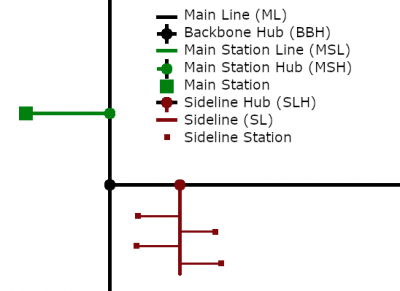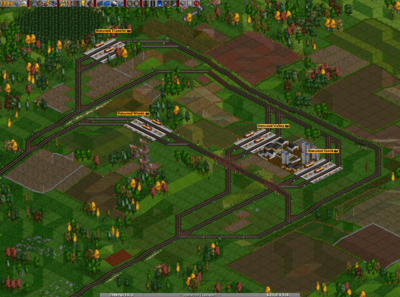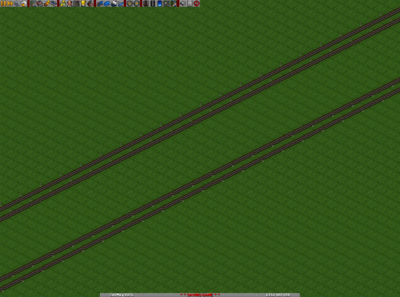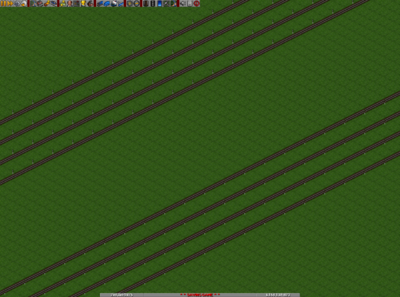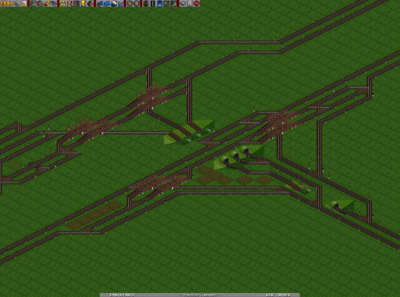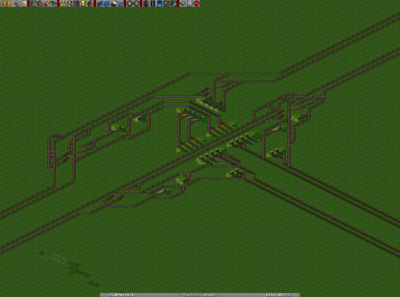Difference between revisions of "Basic Networking"
From #openttdcoop wiki
m (Adde link to penalties) |
|||
| (7 intermediate revisions by 4 users not shown) | |||
| Line 4: | Line 4: | ||
== Line Hierarchy == | == Line Hierarchy == | ||
| − | In our games we [[Gametype:Chaos_Theory|usually]] don't just start building something- this may work in single player games but we found that in order to build large networks in a cooperatively way we needed some sort of relative track importance scheme; a Line Hierarchy. Below you can see an image of this line hierarchy in a schematic way. | + | In our games we [[Gametype:Chaos_Theory|usually]] don't just start building something- this may work in single player games but we found that in order to build large networks in a cooperatively way we needed some sort of relative track importance scheme; a [[Line Hierarchy]]. Below you can see an image of this line hierarchy in a schematic way. |
[[File:line_hierarchy.PNG|400px|thumb|none|The line hierarchy]] | [[File:line_hierarchy.PNG|400px|thumb|none|The line hierarchy]] | ||
| Line 11: | Line 11: | ||
== Sideline station == | == Sideline station == | ||
| − | Sideline stations are the lowest level of the network, here primary cargoes are picked up in small amounts before they are sent to secondary industries. These are usually stations consisting of only two or three platforms per station. However, every cargo type should have its own pickup station; if, for example, a coal mine and a forest are close enough to each other to be covered by a single station there should still be two separate stations with sufficient waiting space in front of them. This rule is also true for farms in the temperate and sub-arctic climate, so you'll have to build two stations to serve a single farm. Below is an example of a cluster of properly built sideline stations, note the split stations for the farm. | + | Sideline stations are the lowest level of the network, here primary cargoes are picked up in small amounts before they are sent to secondary industries. These are usually stations consisting of only two or three platforms per station. However, every cargo type should have its own pickup station; if, for example, consider a coal mine and a forest are close enough to each other to be covered by a single station: there should still be two separate stations with sufficient waiting space in front of them. This rule is also true for farms in the temperate and sub-arctic climate, so you'll have to build two stations to serve a single farm. Below is an example of a cluster of properly built sideline stations, note the split stations for the farm. |
[[File:sideline_stations.PNG|400px|thumb|none|Primary pickup stations]] | [[File:sideline_stations.PNG|400px|thumb|none|Primary pickup stations]] | ||
| Line 18: | Line 18: | ||
== Sideline (SL) == | == Sideline (SL) == | ||
| − | A sideline is a piece of track that connects multiple sideline stations to a sideline hub. The sideline usually has pretty low traffic and suffices with a simple LR track. Also bridges and tunnels on a sideline do not have to be doubled and it is also not needed to receive priority from sideline stations, even though the sideline is in fact higher on the line hierarchy. When our train leaves the sideline it will join the mainline, where it will probably spend the longer part of its journey. | + | A [[sideline]] is a piece of track that connects multiple sideline stations to a sideline hub. The sideline usually has pretty low traffic and suffices with a simple LR track. Also bridges and tunnels on a sideline do not have to be doubled and it is also not needed to receive priority from sideline stations, even though the sideline is in fact higher on the line hierarchy. When our train leaves the sideline it will join the mainline, where it will probably spend the longer part of its journey. |
== Mainline (ML) == | == Mainline (ML) == | ||
| − | + | [[Mainline]]s are the backbones of our networks, they link everything together. Usually they are multiple tracks, ranging from two tracks wide in our relatively small games to eight or more in our bigger ones. The mainline width can be specified in symbols. An L stands for left track, an R stands for right track, an _ stands for an empty space and a number stands for multiple empty spaces. Have a look at the images below, the first image shows a standard LL5RR mainline, the second shows a large capacity L_L_L_L10R_R_R_R mainline. | |
[[File:ML1.PNG|400px|thumb|none|LL5RR]][[File:ML2.PNG|400px|thumb|none|L_L_L_L10R_R_R_R]] | [[File:ML1.PNG|400px|thumb|none|LL5RR]][[File:ML2.PNG|400px|thumb|none|L_L_L_L10R_R_R_R]] | ||
| − | Traffic on these can be very dense, with as little as | + | Traffic on these can be very dense, with as little as 4 tiles spacing between trains for hundreds of consecutive trains. It is easy to see that they have to be free of any obstacles or delays. Bridges and tunnels on mainlines should always be doubled, curves should allow trains to pass at full speed and slopes should be avoided or reduced to such a grade that trains don't slow down while climbing them. Mainlines recieve priority from any other track wanting to join it, the only thing that is more important than a mainline is another, higher density mainline. Now that you know what a ML is, let's get back to our sideline and have a look at the point where it merges with the mainline. |
== Sideline Hub (SLH) == | == Sideline Hub (SLH) == | ||
| − | A | + | A [[Sideline Hub]] is a hub where the sideline joins the mainline. Sidelines should ''always'' be connected to the mainline using a SLH, never connect a sideline, or even worse; a single station, directly to the mainline without using a proper sideline hub. It is important to make all connections that are relevant at the moment or have the potential of becoming relevant in the future. Obviously, when the only drop that is north up the mainline is a goods drop, it is not needed to provide a northbound connection from the sideline, as only primary trains join the mainline at a SLH. On the other side, when you're building a SLH that's only going to connect some coal mines, you do have to provide connections to other primary drops, as a forest might spawn later and someone wants to connect it. |
The actual join should be [[Balancing|balanced]]; the joining sideline should be able to pick from every outgoing mainline track. Needless to say the mainline receives [[Priority|priority]] during the merge, right? | The actual join should be [[Balancing|balanced]]; the joining sideline should be able to pick from every outgoing mainline track. Needless to say the mainline receives [[Priority|priority]] during the merge, right? | ||
| Line 33: | Line 33: | ||
== Backbone hub (BBH) == | == Backbone hub (BBH) == | ||
| − | Backbone | + | [[Backbone Hub]]s are hubs where two or more mainlines meet. These should be fully [[Balancing|balanced]], meaning every incoming track should be able to chose from every outgoing track. Backbone hubs should be connected to all relevant directions, this usually comes down to all directions. The image below shows a properly balanced 3-way with LL_RR mainlines. |
[[File:BBH2.PNG|400px|thumb|none|Balanced and properly built 3-way LL_RR BBH for TL3 trains]] | [[File:BBH2.PNG|400px|thumb|none|Balanced and properly built 3-way LL_RR BBH for TL3 trains]] | ||
| Line 39: | Line 39: | ||
After our train passed through zero or more backbone hubs it will eventually reach a point where it has to leave the mainline to cover the final leg of its route on a main station line. | After our train passed through zero or more backbone hubs it will eventually reach a point where it has to leave the mainline to cover the final leg of its route on a main station line. | ||
| + | |||
| + | == Main station hub (MSH) == | ||
| + | [[MSH|Main station hubs]] are hubs where trains leave/enter the mainline and enter/leave the main station line. Not all games have MSHs, sometimes a ML terminates at a station, bypassing the MSH. Like any other hub, main station hubs only have to connect to relevant directions, unlike for BBHs it happens quite often that you don't have to connect to all directions, which may save you quite some time and reduce complexity. | ||
== Main station line (MSL) == | == Main station line (MSL) == | ||
A main station line is a piece of track that connects the mainline via a main station hub to a main station. These tracks should be treated as mainlines; there should be no obstacles or potential slowdowns. Generally speaking, MSLs should be just as wide as the mainline they are connected too. Sometimes the traffic on the main station line is just as high as on the mainline, making it a bad idea to narrow down the tracks using complex balancing techniques for the relatively short main tracks. It is not allowed to connect sidelines to main station lines as it is very likely this will cause missing directions. There is a [http://openttdcoop.org/2009/06/14/re-introducing-main-station-hubs/ blog article] which goes deeper into potential issues with main station lines and main station hubs. | A main station line is a piece of track that connects the mainline via a main station hub to a main station. These tracks should be treated as mainlines; there should be no obstacles or potential slowdowns. Generally speaking, MSLs should be just as wide as the mainline they are connected too. Sometimes the traffic on the main station line is just as high as on the mainline, making it a bad idea to narrow down the tracks using complex balancing techniques for the relatively short main tracks. It is not allowed to connect sidelines to main station lines as it is very likely this will cause missing directions. There is a [http://openttdcoop.org/2009/06/14/re-introducing-main-station-hubs/ blog article] which goes deeper into potential issues with main station lines and main station hubs. | ||
| − | |||
| − | |||
| − | |||
== Main station == | == Main station == | ||
| − | It's finally unloading time. Main station lines are connected to main | + | It's finally unloading time. Main station lines are connected to [[main station]]s. These are high capacity stations capable of handling a large section of all trains, this sometimes means hundreds or even thousands of trains. Secondary industries often accept one or more input cargo and convert this into one output cargo. At such industries we will always have a separated drop and pickup station. This is to prevent the situation where trains picking up goods keep all platforms occupied and allow no more primaries to come in. You can see this is a very bad situation which may cause a network-wide jam taking years to resolve. Believe me, we know all about these. More information about different types of main station hubs and tips on building them can be found at the [[Main_station|main station section]]. |
| + | |||
| + | |||
| + | ==See Also== | ||
| + | *[[Merging Tracks]] | ||
| + | *[[Relevant Directions]] | ||
| + | *[[Penalties]] | ||
| + | *[[Self-regulating Network]] | ||
| + | *[[Multipoint Self-regulating Network]] | ||
| + | *[[Road Vehicle Networking]] | ||
| + | |||
| + | [[Category:Guides]] | ||
| + | [[Category:Basic networking| ]] | ||
Latest revision as of 08:51, 4 December 2013
During the course of this article you will be introduced to #openttdcoop-style networks on a general level, with possible side trips to more advanced techniques and concepts. It is important to understand that everything stated on this page is true in general, but not necessarily for all games. In fact, an exception could probably be found to every single rule stated here.
Contents
Line Hierarchy
In our games we usually don't just start building something- this may work in single player games but we found that in order to build large networks in a cooperatively way we needed some sort of relative track importance scheme; a Line Hierarchy. Below you can see an image of this line hierarchy in a schematic way.
In this article we'll follow a train starting at a sideline station all the way to its respective drop and introduce all the funky constructions we pass on the way.
Sideline station
Sideline stations are the lowest level of the network, here primary cargoes are picked up in small amounts before they are sent to secondary industries. These are usually stations consisting of only two or three platforms per station. However, every cargo type should have its own pickup station; if, for example, consider a coal mine and a forest are close enough to each other to be covered by a single station: there should still be two separate stations with sufficient waiting space in front of them. This rule is also true for farms in the temperate and sub-arctic climate, so you'll have to build two stations to serve a single farm. Below is an example of a cluster of properly built sideline stations, note the split stations for the farm.
After a train is fully loaded and leaving the sideline station it will move a step up in the hierarchy, onto the sideline.
Sideline (SL)
A sideline is a piece of track that connects multiple sideline stations to a sideline hub. The sideline usually has pretty low traffic and suffices with a simple LR track. Also bridges and tunnels on a sideline do not have to be doubled and it is also not needed to receive priority from sideline stations, even though the sideline is in fact higher on the line hierarchy. When our train leaves the sideline it will join the mainline, where it will probably spend the longer part of its journey.
Mainline (ML)
Mainlines are the backbones of our networks, they link everything together. Usually they are multiple tracks, ranging from two tracks wide in our relatively small games to eight or more in our bigger ones. The mainline width can be specified in symbols. An L stands for left track, an R stands for right track, an _ stands for an empty space and a number stands for multiple empty spaces. Have a look at the images below, the first image shows a standard LL5RR mainline, the second shows a large capacity L_L_L_L10R_R_R_R mainline.
Traffic on these can be very dense, with as little as 4 tiles spacing between trains for hundreds of consecutive trains. It is easy to see that they have to be free of any obstacles or delays. Bridges and tunnels on mainlines should always be doubled, curves should allow trains to pass at full speed and slopes should be avoided or reduced to such a grade that trains don't slow down while climbing them. Mainlines recieve priority from any other track wanting to join it, the only thing that is more important than a mainline is another, higher density mainline. Now that you know what a ML is, let's get back to our sideline and have a look at the point where it merges with the mainline.
Sideline Hub (SLH)
A Sideline Hub is a hub where the sideline joins the mainline. Sidelines should always be connected to the mainline using a SLH, never connect a sideline, or even worse; a single station, directly to the mainline without using a proper sideline hub. It is important to make all connections that are relevant at the moment or have the potential of becoming relevant in the future. Obviously, when the only drop that is north up the mainline is a goods drop, it is not needed to provide a northbound connection from the sideline, as only primary trains join the mainline at a SLH. On the other side, when you're building a SLH that's only going to connect some coal mines, you do have to provide connections to other primary drops, as a forest might spawn later and someone wants to connect it. The actual join should be balanced; the joining sideline should be able to pick from every outgoing mainline track. Needless to say the mainline receives priority during the merge, right?
Backbone hub (BBH)
Backbone Hubs are hubs where two or more mainlines meet. These should be fully balanced, meaning every incoming track should be able to chose from every outgoing track. Backbone hubs should be connected to all relevant directions, this usually comes down to all directions. The image below shows a properly balanced 3-way with LL_RR mainlines.
More information about backbone hubs and example can be found in the BBH section.
After our train passed through zero or more backbone hubs it will eventually reach a point where it has to leave the mainline to cover the final leg of its route on a main station line.
Main station hub (MSH)
Main station hubs are hubs where trains leave/enter the mainline and enter/leave the main station line. Not all games have MSHs, sometimes a ML terminates at a station, bypassing the MSH. Like any other hub, main station hubs only have to connect to relevant directions, unlike for BBHs it happens quite often that you don't have to connect to all directions, which may save you quite some time and reduce complexity.
Main station line (MSL)
A main station line is a piece of track that connects the mainline via a main station hub to a main station. These tracks should be treated as mainlines; there should be no obstacles or potential slowdowns. Generally speaking, MSLs should be just as wide as the mainline they are connected too. Sometimes the traffic on the main station line is just as high as on the mainline, making it a bad idea to narrow down the tracks using complex balancing techniques for the relatively short main tracks. It is not allowed to connect sidelines to main station lines as it is very likely this will cause missing directions. There is a blog article which goes deeper into potential issues with main station lines and main station hubs.
Main station
It's finally unloading time. Main station lines are connected to main stations. These are high capacity stations capable of handling a large section of all trains, this sometimes means hundreds or even thousands of trains. Secondary industries often accept one or more input cargo and convert this into one output cargo. At such industries we will always have a separated drop and pickup station. This is to prevent the situation where trains picking up goods keep all platforms occupied and allow no more primaries to come in. You can see this is a very bad situation which may cause a network-wide jam taking years to resolve. Believe me, we know all about these. More information about different types of main station hubs and tips on building them can be found at the main station section.
